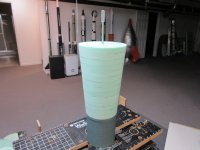Starting to build a crude lathe to turn an 8" max dia, 38" long (44" total with Blue Tube shoulder) nosecone for a 6" dia. Honest John rocket. Spine of the nosecone will be a 3/8" threaded rod. 1" thick sections of foam board insulation will be threaded over the rod and glued to the previous piece of foam board to get to the 38" total nosecone length. At about 14" from the tip of the nosecone, I'll cut a 2" dia. hole from the center of each of six pieces, and add BB's and epoxy for some nose weight. Sandpaper will be used to shape the foam board on the lathe.
So.......how should I put a finish coating of SOMETHING on the foam nosecone? I could use fiberglass cloth, but I can't figure out how to make it conform to the odd shape of this nosecone. I could use several coats of sanding sealer, but that wouldn't give a very durable surface. I could paint on that Flex Seal stuff I see advertised on TV, which seems like a weird but doable option.
What would you recommend? I've already checked pricing for 3D printing, but it is way out of my budget range. A custom wood turning from basswood also is at the fringe of what I'd want to pay, so the foam nosecone seems to be my best option financially, IF I can learn a way to finish the nosecone that would give some strength and look good.
Thanks!
So.......how should I put a finish coating of SOMETHING on the foam nosecone? I could use fiberglass cloth, but I can't figure out how to make it conform to the odd shape of this nosecone. I could use several coats of sanding sealer, but that wouldn't give a very durable surface. I could paint on that Flex Seal stuff I see advertised on TV, which seems like a weird but doable option.
What would you recommend? I've already checked pricing for 3D printing, but it is way out of my budget range. A custom wood turning from basswood also is at the fringe of what I'd want to pay, so the foam nosecone seems to be my best option financially, IF I can learn a way to finish the nosecone that would give some strength and look good.
Thanks!




















